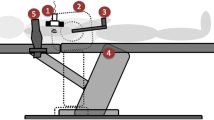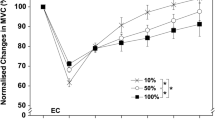Abstract
Purpose
The aim of this study was to analyze the effects of pulsed ultrasound on muscle thickness (MT) and echo intensity (EI) after strenuous exercise.
Methods
Forty healthy untrained male were randomized in either experimental group (n = 20) or placebo group (n = 20). Muscle thickness and EI of the dominant elbow flexors were collected at baseline (PRE), immediately post (0 h), 24, 48, 72, and 96 h after the protocol of damage induction. The protocol of damage induction was performed on an isokinetic dynamometer and consisted of four sets of ten repetitions of maximal eccentric and concentric contractions. The experimental group was treated with pulsed ultrasound (1:4, 1 MHz, 0.8 W/cm2, 23 min) at 0, 24, 48, and 72 h following the protocol of damage induction. The placebo group received the same time of application, but the equipment was kept turned off.
Results
The results demonstrated that MT and EI significantly increased at all time points after the exercise (p < 0.05). However, neither MT nor EI showed any significant difference between groups at any moment (p > 0.05).
Conclusion
Pulsed ultrasound is ineffective in enhancing recovery from exercise-induced muscle damage.



Similar content being viewed by others
References
Buford TW, Cooke MB, Shelmadine BD et al (2009) Effects of eccentric treadmill exercise on inflammatory gene expression in human skeletal muscle. Appl Physiol Nutr Metab 34:745–753
Chen TC, Lin KY, Chen HL et al (2011) Comparison in eccentric exercise-induced muscle damage among four limb muscles. Eur J Appl Physiol 111:211–223. doi:10.1007/s00421-010-1648-7
Brentano MA, Umpierre D, Dos Santos LP et al (2016) Muscle damage and muscle activity induced by strength training super-sets in physically active men. J strength Cond Res Natl Strength Cond Assoc. doi:10.1519/JSC.0000000000001511
Ascensão A, Leite M, Rebelo AN et al (2011) Effects of cold water immersion on the recovery of physical performance and muscle damage following a one-off soccer match. J Sports Sci 29:217–225. doi:10.1080/02640414.2010.526132
Craig JA, Bradley J, Walsh DM et al (1999) Delayed onset muscle soreness: lack of effect of therapeutic ultrasound in humans. Arch Phys Med Rehabil 80:318–323
ter Haar G (2007) Therapeutic applications of ultrasound. Prog Biophys Mol Biol 93:111–129. doi:10.1016/j.pbiomolbio.2006.07.005
Stay JC, Ricard MD, Draper DO et al (1998) Pulsed ultrasound fails to diminish delayed-onset muscle soreness symptoms. J Athl Train 33:341–346
Plaskett C, Tiidus PM, Livingston L (1999) Ultrasound treatment does not affect postexercise muscle strength recovery or soreness. J Sport Rehabil 8:1
Aytar A, Handan Uzün E, Eker L et al (2008) Effectiveness of low-dose pulsed ultrasound for treatment of delayed-onset muscle soreness: a double-blind randomized controlled trial. Isokinet Exerc Sci 16:239–247
Baird MF, Graham SM, Baker JS, Bickerstaff GF (2012) Creatine-kinase- and exercise-related muscle damage implications for muscle performance and recovery. J Nutr Metab. doi:10.1155/2012/960363
Radaelli R, Bottaro M, Wilhelm EN et al (2012) Time course of strength and echo intensity recovery after resistance exercise in women. J Strength Cond Res 26:2577–2584. doi:10.1519/JSC.0b013e31823dae96
Fujikake T, Hart R, Nosaka K (2009) Changes in B-mode ultrasound echo intensity following injection of bupivacaine hydrochloride to rat hind limb muscles in relation to histologic changes. Ultrasound Med Biol 35:687–696. doi:10.1016/j.ultrasmedbio.2008.10.008
Vieira A, Siqueira AF, Ferreira-junior JB (2014) Ultrasound imaging in women’ s arm flexor muscles: intra-rater reliability of muscle thickness and echo intensity. Braz J Phys Therapy. doi:10.1590/bjpt-rbf.2014.0186
Newton MJ, Morgan GT, Chapman DW, Nosaka KK (2008) Comparison of responses to strenuous eccentric exercise of the elbow flexors between resistance-trained and untrained men. J Strength Cond Res 22:597–607. doi:10.1519/JSC.0b013e3181660003
Enns DL, Tiidus PM (2010) The influence of estrogen on skeletal muscle: sex matters. Sport Med 40:41–58. doi:10.2165/11319760-000000000-00000
Flores DF, Gentil P, Brown LE et al (2011) Dissociated time course of recovery between genders after resistance exercise. J Strength Cond Res 25:3039–3044. doi:10.1519/JSC.0b013e318212dea4
Lima CS, Medeiros DM, Prado LR et al (2017) Local cryotherapy is ineffective in accelerating recovery from exercise-induced muscle damage on biceps brachii. Sport Sci Health. doi:10.1007/s11332-017-0355-8
Nosaka K, Newton M, Sacco P et al (2005) Partial protection against muscle damage by eccentric actions at short muscle lengths. Med Sci Sports Exerc 37:746–753. doi:10.1249/01.MSS.0000162691.66162.00
Radaelli R, Bottaro M, Wagner DR et al (2014) Men and women experience similar muscle damage after traditional resistance training protocol. Isokinet Exerc Sci 22:47–54. doi:10.3233/IES-130519
Proske U, Morgan DL (2001) Muscle damage from eccentric exercise: mechanism, mechanical signs, adaptation and clinical applications. J Physiol 537:333–345. doi:10.1111/j.1469-7793.2001.00333.x
MacIntyre DL, Sorichter S, Mair J et al (2001) Markers of inflammation and myofibrillar proteins following eccentric exercise in humans. Eur J Appl Physiol 84:180–186. doi:10.1007/s004210170002
McCully KK, Faulkner JA (1985) Injury to skeletal muscle fibers of mice following lengthening contractions. J Appl Physiol 59:119–126
Young HJ, Jenkins NT, Zhao Q, Mccully KK (2015) Measurement of intramuscular fat by muscle echo intensity. Muscle Nerve 52:963–971. doi:10.1002/mus.24656
Fukumoto Y, Ikezoe T, Yamada Y et al (2012) Skeletal muscle quality assessed from echo intensity is associated with muscle strength of middle-aged and elderly persons. Eur J Appl Physiol 112:1519–1525. doi:10.1007/s00421-011-2099-5
Cadore EL, Izquierdo M, Conceição M et al (2012) Echo intensity is associated with skeletal muscle power and cardiovascular performance in elderly men. Exp Gerontol 47:473–478. doi:10.1016/j.exger.2012.04.002
Picelli A, Bonetti P, Fontana C et al (2012) Is spastic muscle echo intensity related to the response to botulinum toxin type a in patients with stroke? A cohort study. Arch Phys Med Rehabil 93:1253–1258. doi:10.1016/j.apmr.2012.02.005
Peake JM, Nosaka K, Muthalib M, Suzuki K (2006) Systemic inflammatory responses to maximal versus submaximal lengthening contractions of the elbow flexors. Exerc Immunol Rev 12:72–85
Kanda K, Sugama K, Hayashida H et al (2013) Eccentric exercise-induced delayed-onset muscle soreness and changes in markers of muscle damage and inflammation. Exerc Immunol Rev 19:72–85
Jones DA, Newham DJ, Round JM, Tolfree SE (1986) Experimental human muscle damage: morphological changes in relation to other indices of damage. J Physiol 375:435–448
Stupka N, Lowther S, Chorneyko K et al (2000) Gender differences in muscle inflammation after eccentric exercise. J Appl Physiol 89:2325–2332
Zainuddin Z, Newton M, Sacco P, Nosaka K (2005) Effects of massage on delayed-onset muscle soreness, swelling, and recovery of muscle function. J Athl Train 40:174–180. doi:10.1136/bjsm.37.1.72
Hill J, Howatson G, Van Someren K et al (2014) Compression garments and recovery from exercise-induced muscle damage: a meta-analysis. Br J Sport Med 48:1340–1346. doi:10.1136/bjsports-2013-092456
Crane JD, Ogborn DI, Cupido C et al (2012) Massage therapy attenuates inflammatory signaling after exercise-induced muscle damage. Sci Transl Med 4:119-ra13. doi:10.1126/scitranslmed.3002882
Tseng C-Y, Lee J-P, Tsai Y-S et al (2013) Topical cooling (icing) delays recovery from eccentric exercise-induced muscle damage. J Strength Cond Res 27:1354–1361. doi:10.1519/JSC.0b013e318267a22c
Malm C, Yu JG (2012) Exercise-induced muscle damage and inflammation: re-evaluation by proteomics. Histochem Cell Biol 138:89–99. doi:10.1007/s00418-012-0946-z
Urso ML (2013) Anti-inflammatory interventions and skeletal muscle injury: benefit or detriment? J Appl Physiol 115:920–928. doi:10.1152/japplphysiol.00036.2013
Hasson S, Mundorf R, Barnes W et al (1990) Effect of pulsed ultrasound versus placebo on muscle soreness perception and muscular performance. Scand J Rehabil Med 22:199–205
Acknowledgements
The authors thank the National Counsel of Technological and Scientific Development for the scientific initiation scholarship.
Author information
Authors and Affiliations
Corresponding author
Ethics declarations
Conflict of interest
The authors declare that they have no conflict of interest.
Ethical approval
All procedures of the present study were approved by the Federal University of Rio Grande do Sul Review Board, and they were performed in accordance with the ethical standards of the 1964 Helsinki Declaration and its later amendments or comparable ethical standards.
Informed consent
Informed consent was obtained from all individual participants included in the study.
Rights and permissions
About this article
Cite this article
Medeiros, D.M., Mantovani, R.F. & Lima, C.S. Effects of low-intensity pulsed ultrasound on muscle thickness and echo intensity of the elbow flexors following exercise-induced muscle damage. Sport Sci Health 13, 365–371 (2017). https://doi.org/10.1007/s11332-017-0366-5
Received:
Accepted:
Published:
Issue Date:
DOI: https://doi.org/10.1007/s11332-017-0366-5




